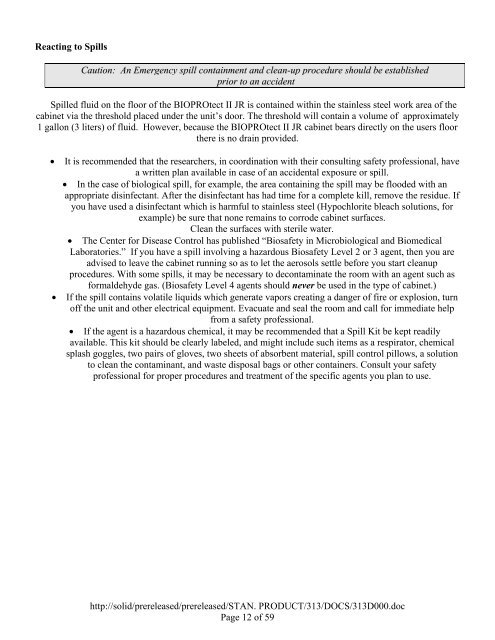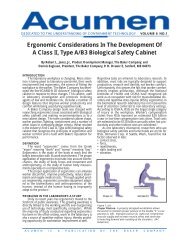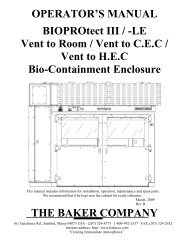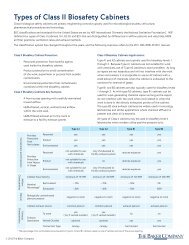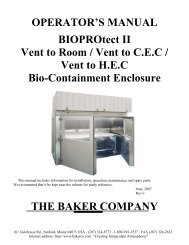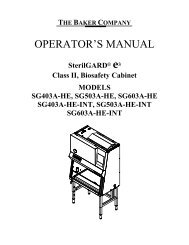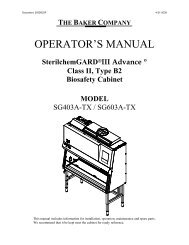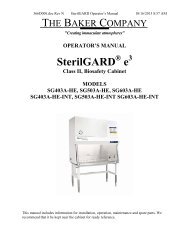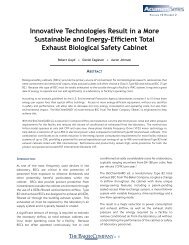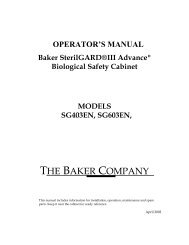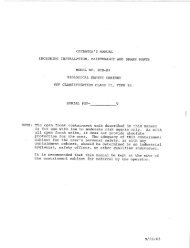OPERATOR'S MANUAL BIOPROtect II JR Vent to ... - Baker Company
OPERATOR'S MANUAL BIOPROtect II JR Vent to ... - Baker Company
OPERATOR'S MANUAL BIOPROtect II JR Vent to ... - Baker Company
Create successful ePaper yourself
Turn your PDF publications into a flip-book with our unique Google optimized e-Paper software.
Reacting <strong>to</strong> Spills<br />
Caution: An Emergency spill containment and clean-up procedure should be established<br />
prior <strong>to</strong> an accident<br />
Spilled fluid on the floor of the <strong>BIOPROtect</strong> <strong>II</strong> <strong>JR</strong> is contained within the stainless steel work area of the<br />
cabinet via the threshold placed under the unit’s door. The threshold will contain a volume of approximately<br />
1 gallon (3 liters) of fluid. However, because the <strong>BIOPROtect</strong> <strong>II</strong> <strong>JR</strong> cabinet bears directly on the users floor<br />
there is no drain provided.<br />
• It is recommended that the researchers, in coordination with their consulting safety professional, have<br />
a written plan available in case of an accidental exposure or spill.<br />
• In the case of biological spill, for example, the area containing the spill may be flooded with an<br />
appropriate disinfectant. After the disinfectant has had time for a complete kill, remove the residue. If<br />
you have used a disinfectant which is harmful <strong>to</strong> stainless steel (Hypochlorite bleach solutions, for<br />
example) be sure that none remains <strong>to</strong> corrode cabinet surfaces.<br />
Clean the surfaces with sterile water.<br />
• The Center for Disease Control has published “Biosafety in Microbiological and Biomedical<br />
Labora<strong>to</strong>ries.” If you have a spill involving a hazardous Biosafety Level 2 or 3 agent, then you are<br />
advised <strong>to</strong> leave the cabinet running so as <strong>to</strong> let the aerosols settle before you start cleanup<br />
procedures. With some spills, it may be necessary <strong>to</strong> decontaminate the room with an agent such as<br />
formaldehyde gas. (Biosafety Level 4 agents should never be used in the type of cabinet.)<br />
• If the spill contains volatile liquids which generate vapors creating a danger of fire or explosion, turn<br />
off the unit and other electrical equipment. Evacuate and seal the room and call for immediate help<br />
from a safety professional.<br />
• If the agent is a hazardous chemical, it may be recommended that a Spill Kit be kept readily<br />
available. This kit should be clearly labeled, and might include such items as a respira<strong>to</strong>r, chemical<br />
splash goggles, two pairs of gloves, two sheets of absorbent material, spill control pillows, a solution<br />
<strong>to</strong> clean the contaminant, and waste disposal bags or other containers. Consult your safety<br />
professional for proper procedures and treatment of the specific agents you plan <strong>to</strong> use.<br />
http://solid/prereleased/prereleased/STAN. PRODUCT/313/DOCS/313D000.doc<br />
Page 12 of 59


